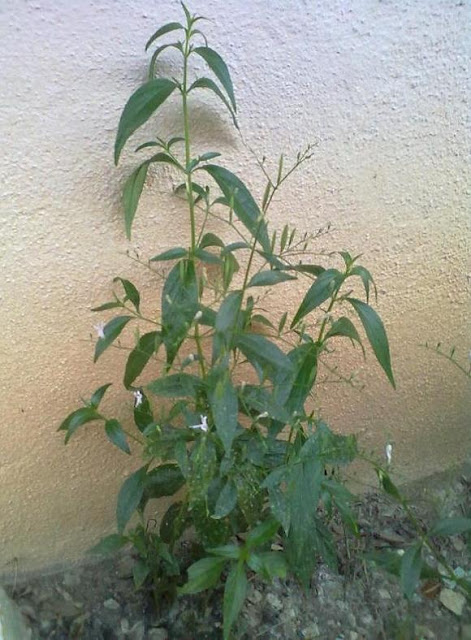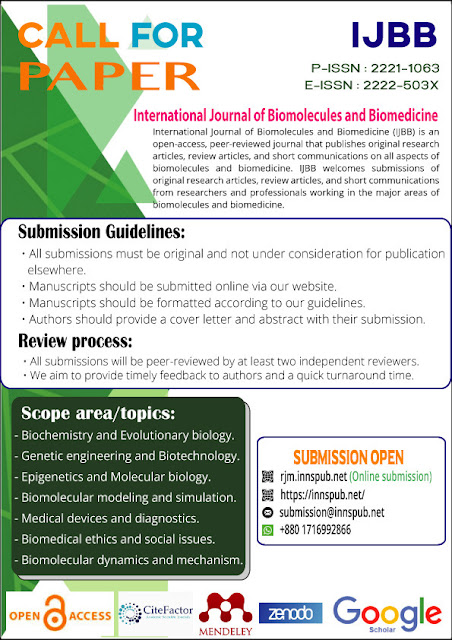Manoharan Sivananthan, and Manoharan Elamaran, from the different
institute of the Malaysia. wrote a research article about, Andrographis
Paniculata: Exploring Medicinal Marvels. entitled, Medicinal and
pharmacological properties of Andrographis paniculata. This research paper
published by the International Journal of Biomolecules and Biomedicine (IJBB). an
open access scholarly research journal on Biomedicine. under the affiliation
of the International Network For Natural Sciences | INNSpub. an
open access multidisciplinary research journal publisher.
Abstract
A lot of literature reviews about Andrographis paniculata has been published previously. Researchers are critically involved in the research to extract out the potential medicinal value that possess by the “King of Bitter”. It has a broad pharmacological value. Traditionally many disease condition have been treated successfully. The success of the plant is due to the presence of few bioactive compounds such as andrographolide, homo-andrographolide andrographesterol, andrographopne which are identified through the phythochemistry studies of the plant which are having the wide therapeutic activities. The extremely bitter taste of the plant is due the compound known as andrographolide. However this bitter plant is having a sweet future for those appreciated the benefits of the plant. From the review it is proven that Andrographis paniculata is having antioxidant, hepatoprotective, antimicrobial, anticancer, antivenom, anti HIV, antimalarial, antipyretic, antifertility, antidiarrhoeal, antidiabetic, antihiperlipidemic activities. Variety of literature concerning about the toxicity studies has confirmed that the plant is safe to consume although few findings revealed that consuming Andrographis paniculata for a long period of time may possess some unwanted action especially in the fertility studies.
Read more : Microbial Biopesticides: Controlling Xanthomonas citri in Cashew | InformativeBD
Introduction
Andrographis paniculata
is a plant that has been effectively used in traditional Asian medicines for
centuries. Its perceived “blood purifying” property results in its use in
diseases where blood “abnormalities” are considered causes of disease, such as
skin eruptions, boils, scabies, and chronic undetermined fevers. The aerial
part of the plant, used medicinally, contains a large number of chemical
constituents, mainly lactones, diterpenoids, diterpene glycosides, flavonoids,
and flavonoid glycosides. Controlled clinical trials report its safe and effective
use for reducing symptoms of uncomplicated upper respiratory tract infections.
Since many of the disease conditions commonly treated with Andrographis
paniculata in traditional medical systems are considered self-limiting, its
purported benefits need critical evaluation (Akbar, 2011).
Andrographis paniculata
grows widely in many Asian countries, such as China, India, Thailand and Sri
Lanka and has a long history of therapeutic usage in Indian and Oriental
medicine. The herb is official in Indian Pharmacopoeia as a predominant
constituent of at least 26 Ayurvedic formulations used to treat liver
disorders. It is one of the herbs, which can be used to treat neoplasm as
mentioned in ancient Ayurvedic literature. Andrographis paniculata is reported
as a cold property herb in Traditional Chinese medicine (TCM) and is used to
get rid of body heat and to expel toxins (Majee et al., 2011). Table 1
represent the taxonomy of Andrographis paniculata (Alireza et al., 2011).
Andrographolide, a
bitter principle obtained from Andrographis paniculata is a diterpene lactone,
responsible for various pharmacological activities. This is a well known
phytoconstituent from Indian System of Medicine, used in the management of
different diseases since time immemorial. Research activities worldwide to
exhibit the beneficial role of Andrographolide are continuously enriching the
therapeutic arsenal of this important phytomolecule. In addition to the well
known pharmacological activities like hepatoprotective, antioxidant, hypoglycemic
etc., recent advances in the management of immune system and neoplastic
diseases make andrographolide the phytomolecule of the hour (Maiti et al.,
2006). The therapeutic value of Andrographis paniculata is due to its mechanism
of action which is perhaps by enzyme induction (Meenatchisundaram et al.,
2009).
Reference
Akbar S. 2011.
Andrographis paniculata: A Review of Pharmacological Activities and Clinical
Effects. Alternative Medicine Review 16(1), 66- 77.
Akbarsha MA, Manivannan B, Hamid KS, Vijayan B.
1990. Antifertility effect of Andrographis paniculata (Nees) in male
albino rat. Indian Journal of Experimental Biology 28(5), 421-426.
Alamgir MH, Roy BK,
Ahmed K, Chowdhury AMS, Rashid MA. 2007. Antidiabetic Activity of Andrographis
paniculata. Dhaka University Journal of Pharmaceutical Sciences 6(1), 15-
20.
Alireza V, Mihdzar AK,
Soon GT, Daryush T, Mohd PA, Sonia N. 2011. Nain-e Havandi Andrographis
paniculata present yesterday, absent today: a plenary review on
underutilized herb of Iran’s pharmaceutical plants. An International Journal on
Molecular and Cellular Biology 39(5), 5409- 5424, http://dx.doi.org/10.1007/s11033-011-1341-x
Borhanuddin
M, Shamsuzzoha M, Hussain AH. 1994. Hypoglycaemic effects
of Andrographis paniculata Nees on non-diabetic rabbits. Bangladesh
Medical Research Council Bulletin 20(1), 24- 26.
Dandu AM, Inamdar NM. 2009.
Evaluation if beneficial effects of antioxidant properties of aqueous leaf
extract of andrographis paniculata in stz- induced diabetes. Pakistan Journal
of Pharmacuetical Science 22(1), 49- 52.
Devaraj S,
Jegathambigai R, Kumar P, Sivaramakrishnan S. 2010. Study on the
hepatoprotective effect of androgaraphis paniculata (Burm. f) nees on mice.
Journal of Phytology 2(11), 25- 30.
Doss VA, Kalaichelvan
PT. 2012. In vitro antimicrobial and antioxidant activity screening of Andrographis
paniculata leaf ethanolic extract in Tamil Nadu. International Journal of
Pharmacy and Pharmaceutical Sciences 4(1), 227- 229.
Dua VK, Ojha VP, Roy R, Joshi BC, Valecha N, Devi
CU, Bhatnagar MC, Sharma VP, Subbarao SK. 2004.
Anti-malarial activity of some xanthones isolated from the roots of Andrographis
paniculata. Journal of Ethnopharmacology. 95(2-3), 247-251.
Harjotaruno S,
Widyawaruyanti A, Sismindari, Zaini NC. 2007. Apoptosis inducing effect of
andrographis paniculata on TD-47 human breast cancer cell line. African Journal
of Traditional Complementary and Alternative Medicines 4(3), 345–
351.
Hosamani PA, Lakshman
HC, Sandeepkumar K, Hosamani RC 2011. Antimicrobial Activity of Leaf
extract of Andrographis paniculata Wall. Science Research
Reporter 1(2), 92 – 95.
Huidrom S, Deka M. 2012.
Determination of antioxidant property of Andrographis paniculata. Indian
Journal of Drugs and Diseases. 1(1), 12- 17.
Jarukamjorn K, Nemoto
N. 2008. Pharmacological aspect of Andrographis paniculata on
health and its major diterpenoid constituent andrographolide. Journal of Health
Science 54(4), 370-381.
Kalaivani CS, Sathish
SS, Janakiraman N, Johnson M. 2012. GC-MS studies on Andrographis
paniculata (Burm. f), Wall. ex Nees – a medicinally important plant.
International Journal of Medical Aroma Plant. 2(1), 69- 74.
Kumar A, Dora J, Singh
A, Tripathi R. 2012. A review on king of bitter (Kalmegh). International
journal of research in pharmacy and chemistry 2(1), 116- 124.
Kumar RA, Sridevi
K, Kumar NV, Nanduri S, Rajagopal S. 2004. Anticancer and immunostimulatory
compounds from Andrographis paniculata. Journal of Ethnopharmacology. 92(2-3),
291-295.
Maiti K, Gantait A,
Mukherjee K, Saha BP, Mukherjee PK. 2006. Therapeutic potentials of
Andrographolide from Andrographis paniculata : A review. Journal of Natural
Remedies 6(1), 1 – 13.
Majee C, Gupta BK,
Mazumder R, Chakraborthy GS. 2011. HPLC Method Development and
Characterization of Bio-Active Molecule Isolated from Andrographis paniculata.
International Journal of Pharm Tech Research 3(3), 1586- 1592.
Meenatchisundaram S,
Parameswari G, Subbraj T, Suganya T, Michael A. 2009. Medicinal and
Pharmacological Activities of Andrographis paniculata –Review.
Ethnobotanical Leaflets 13, 55- 58.
Mishra K , Dash AP,
Swain BK, Dey N. 2009. Anti-malarial activities of Andrographis
paniculata and Hedyotis corymbosa extracts and their combination
with curcumin. Malaria Journal 8, 26, http://dx.doi.org/10.1186
/1475-2875-8-26
Mishra US, Mishra A, Kumari R, Murthy PN, Naik BS. 2009.
Antibacterial Activity of Ethanol Extract of Andrographis paniculata. Indian
Journal of Pharmaceutical Science. 71(4), 436–438, http://dx.doi.org/10.4103/0250-474X.57294
Mulukuri VLS, Mondal
NB, Prasad MR, Renuka S, Ramakrishna K. 2011. Isolation of Diterpenoid
Lactones from the Leaves of Andrographis Paniculata and Its Anticancer
Activity. International Journal of Pharmacognosy and Phytochemical
Research 3(3), 39-42.
Nagalekshmi R, Menon A,
Chandrasekharan DK, Nair CK. 2011. Hepatoprotective activity of Andrographis
paniculata and Swertia chirayita. Food and Chemical Toxicology.
49(12), 3367-3373, http://dx.doi.org/10.1016/j.fct.2011.09.026
Nugroho AE, Andrie
M, Warditiani NK, Siswanto E, Pramono S, Lukitaningsih
E. 2012. Antidiabetic and antihiperlipidemic effect of Andrographis
paniculata (Burm. f.) Nees and andrographolide in high-fructose-fat-fed
rats. Indian Journal of Pharmacology 44(3), 377- 381.
Ojha SK, Nandave M,
Kumari S, Arya DS. 2009. Antioxidant Activity of Andrographis
paniculata in Ischemic Myocardium of Rats. Global Journal of
Pharmacology 3(3), 154- 157.
Parashar R, Upadhyay A,
Singh J, Diwedi SK, Khan NA. 2011. Morpho-Physiological Evaluation of Andrographis
paniculata at Different Growth Stages. World Journal of Agricultural
Sciences 7(2), 124- 127.
Patidar S, Gontia AS,
Upadhyay A, Nayak PS. 2011. Biochemical Constituents in Kalmegh (Andrographis
paniculata Nees.) Under Various Row Spacing’s and Nitrogen Levels. World
Applied Sciences Journal 15(8), 1095- 1099.
Pitinidhipat N, Yasurin
P. 2012. Antibacterial Activity of Chrysanthemum indicum, Centella
asiatica and Andrographis paniculata against Bacillus
cereus and Listeria monocytogenes under Osmotic Stress. AU
Journal of Technology 15(4), 239- 245.
Radhika P, Lakshmi KR. 2010.
Antimicrobial Activity of the Chloroform Extracts of the Root and the Stem
of Andrographis paniculata Nees. International Research Journal of
Microbiology 1(2), 37- 39.
Rafat A, Philip K,
Muniandy S. 2010. Antioxidant potential and content of phenolic compounds
in ethanolic extracts of selected parts of Andrographis paniculata. Journal
of Medicinal Plants Research. 4(3), 197– 202.
Rajalakshmi G, Aruna D,
Bhuvaneswari B, Venkatesan RS, Natarajan A, Jegatheesan K. 2012.
Prophylactic effect of Andrographis paniculata extracts against
fungal species. Journal of Applied Pharmaceutical Science 2(9), 58-60, http://dx.doi.org/10.7324/JAPS.2012.2912
Rao NK. 2005.
Anti-Hyperglycemic and Renal Protective Activities of Andrographis
paniculata Roots Chloroform Extract. Iranian journal of pharmacology &
Therapeutics. 5, 47- 50.
Sattayasai J, Srisuwan
S, Arkaravichien T, Aromdee C. 2010. Effects of andrographolide on sexual
functions, vascular reactivity and serum testosterone level in rodents. Food
and Chemical Toxicology 48, 1934– 1938.
Sharma M, Joshi S. 2011.
Comparison of antioxidant activity of Andrographis paniculata and Tinospora
cordifolia leaves. Journal of Current Chemical and Pharmaceutical
Science 1(1), 1- 8.
Sharma M, Sharma RG,
Rawat RD, Sharma N. 2011. Evaluation of phytochemical and antibacterial
activity of hot and cold methanolic extract of leaves and whole plant of Andrographis
paniculata. International Journal of Chemical Science 9(3), 960-968.
Singha PK, Roy
S, Dey S. 2003. Antimicrobial activity of Andrographis
paniculata. Fitoterapia 74(7-8), 692-694.
Sivananthan M, Elamaran
M. 2013. In vitro evaluation of antibacterial activity of
chloroform extract Andrographis paniculata leaves and roots, Durio
zibethinus wood bark and Psidium guajava leaves against selected
bacterial strains. International Journal of Biomolecule and Biomedicine 3(1), 12-
19.
Sule A, Ahmed QU, Latip
J, Samah OA, Omar MN, Umar A, Dogarai BB. 2012. Antifungal activity
of Andrographis paniculata extracts and active principles against
skin pathogenic fungal strains in vitro. Pharmaceutical Biology 50(7), 850-
856, http://dx.doi.org/10.3109/13880209.2011.641021
Tang LIC, Ling APK, Koh
RY, Chye SM, Voon KGL. 2012. Screening of anti dengue activity in
methanolic extracts of medicinal plants. Biomedical Central Complement Alternative
Medicine 13, 12-13, http://dx.doi.org/10.1186/1472-6882-12-3
Vetriselvan S,
Rajamanikkam V, Devi P, Subasini, Arun G. 2010. Comparative evaluation of
hepatoprotective activity of Andrographis paniculata and Silymarin in
ethanol induced hepatotoxicity in albino wistar rats. Der Pharmacia
Lettre 2(6), 52- 59.
Wasman SQ, Mahmood AA,
Chua LS, Alshawsh MA, Hamdan S. 2011. Antioxidant and gastroprotective
activities of Andrographis paniculata (Hempedu Bumi) in Sprague
Dawley rats. Indian Journal of Experimental Biology 49(10), 767- 772.
Wiart C, Kumar K, Yusof MY, Hamimah H, Fauzi
ZM, Sulaiman M. 2005. Antiviral properties of ent-labdene diterpenes
of Andrographis paniculata nees, inhibitors of herpes simplex virus
type 1. Phytotheraphy Research 19(12), 1069- 1070.
Source : Medicinal and pharmacological properties of Andrographis paniculata











%20in%20full.JPG)


0 comments:
Post a Comment